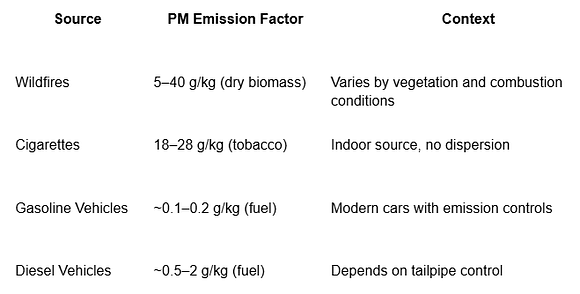By Sissi Liu as published on Medium
As wildfires rage more frequently, the makeup of the air we breathe is shifting — bringing new and poorly understood risks. Particulate matter (PM) pollution, long associated with vehicles and industrial activity, is increasingly coming from sources that are harder to control. One study shows that wildfire smoke may be 10 times more harmful than other types of pollution sources, especially in the case of children.[1] Another toxicological study suggests that wildfire smoke particles may be more harmful than equivalent amounts of typical ambient PM2.5.[2] This raises a crucial question: how should we compare wildfire smoke with top air pollutants such as cigarette smoke and car emissions, and what does that mean for our health?
PM Emission Factor
A key tool scientists use to compare air pollution sources is the particulate matter (PM) emission factor — a metric that quantifies how much PM is released per unit of fuel burned. It’s widely used to model air quality, predict exposure, and estimate health impacts. In particular, it enables side-by-side comparisons between sources like wildfires, cigarettes, and vehicles — and the results might surprise you.
A PM emission factor (EF) measures how much particulate matter is released for every kilogram of fuel burned — whether that fuel is wood, tobacco, or gasoline. Expressed in grams per kilogram (g/kg),[3] it’s a helpful way to quantify and compare the pollution footprint of activities like driving a car, smoking a cigarette, or the large-scale combustion of a wildfire.
By translating pollution into comparable numbers, PM emission factors make the invisible visible. Whether it’s a smoldering forest or an idling truck, this metric helps clarify what’s more polluting in the air we breathe.
How Wildfires, Cigarettes, and Cars Stack Up
Now that we’ve defined what a PM emission factor is, we can use it to put wildly different sources of pollution — like wildfires, cigarettes, and vehicle exhaust — on equal footing. The differences in emissions per kilogram of fuel are striking, and they offer a new perspective on which sources are dirtiest.

It might be shocking to see that a single cigarette produces ~150–300X more PM than a gasoline car, per unit of fuel burned. And wildfires? They can produce ~200–400X more–and there’s no catalytic converter or filter tip to stop it.
CO-based PM Normalization
The raw emission factors already tell a compelling story — but we can take the comparison a step further by normalizing particulate matter to carbon monoxide (CO), a byproduct of incomplete combustion. This PM₂.₅-to-CO ratio helps account for factors like fire size, fuel type, or engine load, making it easier to compare how “particle-rich” different sources are.
In a 2022 study published in Atmospheric Chemistry and Physics, scientists found that wildfires emit 15–19 times more PM₂.₅ per unit of CO than motor vehicles.[4] In other words, for every gram of CO released, wildfire smoke carries far more particulate pollution — suggesting greater potential for toxicity and health risks.
Not Just More PM — Worse PM
Emission factors help quantify how much PM pollution is released — but that’s only part of the story. Wildfire smoke isn’t just higher in PM; it’s composed of especially hazardous particles. Increasingly, research shows that wildfire smoke is more toxic than other pollution sources for several reasons:
- Particle size: Wildfire smoke is dominated by super-fine particles (predominantly 0.1–0.3 μm), small enough to penetrate deep into the lungs and enter the bloodstream.
- Chemical reactivity: These particles are chemically reactive and can carry toxic or carcinogenic compounds.
- Persistence and spread: Smoke lingers in the atmosphere, travels vast distances, and penetrates indoor spaces.
- Widespread exposure: Unlike cigarette smoke, which primarily affects the smoker and nearby individuals, wildfire smoke can impact entire regions — especially vulnerable groups like children, the elderly, and those with respiratory or cardiovascular conditions.
At first glance, cigarette smoke and wildfire smoke may seem comparable — both contain fine particles and harmful chemicals. But their sources and exposure patterns differ dramatically. Cigarette smoke largely comes from a single, well-characterized source: burning tobacco. Wildfire smoke, by contrast, arises from complex fuel mixtures — wood, grass, and even plastics, electronics, and construction materials — especially in wildland-urban interface (WUI) fires. This makes its toxicology far more complex and more harmful.
The health risks speak for themselves. Wildfire smoke has been linked to:
- Heart attacks and strokes
- Asthma flare-ups
- Cancer and neurological effects
- Cognitive decline and dementia
- Premature death
What Can Be Done?
By combining emission factors with knowledge of particle composition and size, researchers can better assess real-world health risks — and identify interventions such as filtration or public health guidance.
- Mitigate wildfires and risks through better land use, policies, and technology implementation.
- Improve indoor air quality with effective filtration, especially during wildfire season.
- Enforce and update emissions standards for all sources.
Final Thoughts
Whether it’s the tailpipe of a diesel truck, the tip of a cigarette, or a blazing forest, combustion sends PM into the air, harming human health. Wildfire smoke, in particular, is changing the game: it’s more widespread, more dangerous, and harder to control. Emission factors shed light on why — helping quantify how much more particulate matter wildfires produce compared to other sources. But they do more than measure the problem. In a changing world, they remind us that protecting clean air will require smarter tools, appropriate interventions, and renewed urgency.
References
- Aguilera, R. et al. “Fine Particles in Wildfire Smoke and Pediatric Respiratory Health in California” Pediatrics (2021). https://publications.aap.org/pediatrics/article-abstract/147/4/e2020027128/180791/Fine-Particles-in-Wildfire-Smoke-and-Pediatric
- Aguilera, R., Corringham, T., Gershunov, A. et al. “Wildfire smoke impacts respiratory health more than fine particles from other sources: observational evidence from Southern California.” Nature Communications 12, 1493 (2021). https://doi.org/10.1038/s41467-021-21708-0
- Urbanski, S.P., O’Neill, S.M., Holder, A.L., Green, S.A., Graw, R.L. Emissions. In: Peterson, D.L., McCaffrey, S.M., Patel-Weynand, T. (eds) Wildland Fire Smoke in the United States. Springer, Cham. (2022). https://doi.org/10.1007/978-3-030-87045-4_5
- Jaffe, D. A., Schnieder, B., and Inouye, D.: Technical note: Use of PM2.5 to CO ratio as an indicator of wildfire smoke in urban areas, Atmos. Chem. Phys., 22, 12695–12704 (2022). https://doi.org/10.5194/acp-22-12695-2022,

Tatama Air Cleaner
For commercial new construction or retrofits into existing facilities
Tatama uses Metalmark’s advanced HEPA-grade filters to capture airborne particulates, smoke, VOCs, and pathogens, including viruses and bacteria.

Sierra Air Filters
For your existing commercial HVAC systems
The HVAC filter with enhanced protection against wildfire smoke. A simple drop-in replacement with no change to air flow or pressure.



